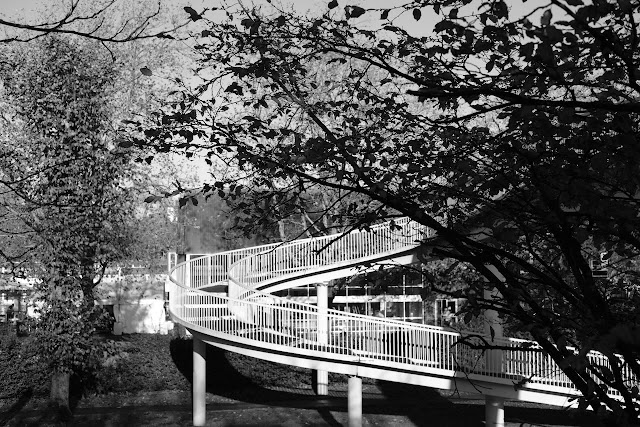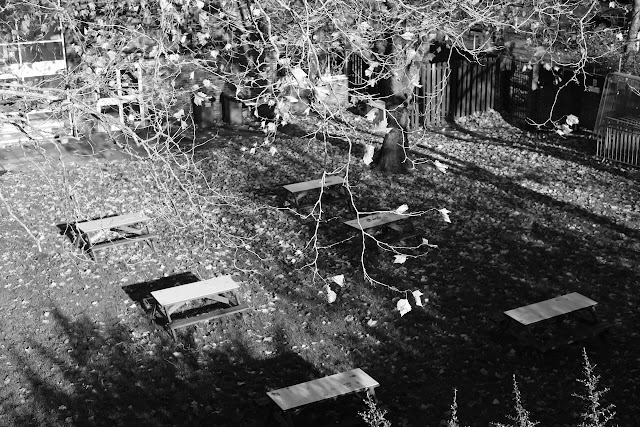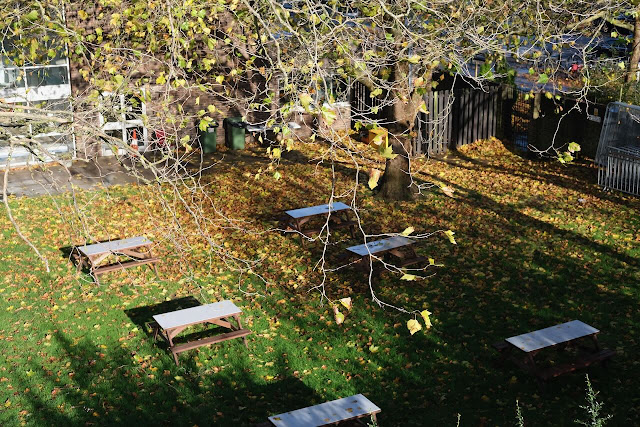Friday, 2 December 2022
Bruckner 9 at the RFH
I've heard a big ol' pipe organ, and some older and modern chamber music. I have not been amazed by the difference between live and my hi-fi. My generic memory from when I used to listen to live chamber music was that it was much better than anything I could get at home. That was a good few years ago, and my reaction now speaks to a) the vastly improved quality of digital sources, DACs, amplifiers and speakers, and possibly b) the deterioration of my hearing.
For Bruckner 9, I was two seats to the left of the conductor and two rows back from the orchestra. I could hear the cellos and violas on the right, the violins on the left, and the horns and winds in the middle. With a clarity that is simply not available on a hi-fi. Unless maybe one plays it at 80+ dBA, which would have the neighbours complaining. (I tested the bit where the orchestra comes out and everyone plays through the bits they find difficult one more time, and that was around 80dBA.)
When the orchestra was giving it the full triple-forte, even close up, it was an overwhelming wall of sound dominated by the cellos, violas, brass and woodwind. I could see the basses sawing away over to the right, and the second violins over to the left behind the first violins pretty much disappeared as well. When the wind section stopped playing and the cellos calmed down, then I could hear the basses and the second violins. This is pretty much the experience of listening to a CD as well: it's a function of the sheer volume that cellos, violas and wind can put out. It's why a lot of orchestral recordings seem to be biased to the right: because that's where all the noise is.
When the orchestra was playing at regular or piano intensity, the depth and quality of the sound easily exceeded anything I've heard on CD or CD-quality streaming over the speakers and certainly over headphones.
No comparison. Totally different experience. I have two more chamber music tickets left from this round, and next year I'm only doing Big Bands doing Big Band music. I will change up where I sit as well.
Sitting that close... no comparison between a live and hi-fi. Live was a real experience.
Tuesday, 29 November 2022
Royal Airforce Museum - Lancaster
Sis and I took a trip to the RAF Museum in Colindale (Northern Line and take the bus). It's free and it is well worth the visit. They have the bi-planes and tri-planes and jet planes and the WW2 stuff. And then there is this mofo. It's big. Nope, it's bigger than that. Only the Vulcan is bigger, but not even the Vulcan has the sheer presence of this beast.
Tech note: not my finest shots, but doesn't blur look better in B&W?
Friday, 25 November 2022
More B&W - I'm Starting To Like This (Richmond on Thames)
Oh yes, I like these three. Impossible in colour.
Also, I use f4 as my default, since on an APS-C frame f8 gives way too much depth of focus. The first photo would not work if I used f8.
Tuesday, 22 November 2022
Black and White vs Colour (Richmond on Thames)
Some subjects are better done in B&W, and others in colour.
Here the B&W looks a little self-conscious, whereas the colour one looks like a picture.
Whereas these...
...are what B&W is for. You have to look for the person, but once you see them, there's nothing to distract you from them.
Friday, 18 November 2022
First B&W Pictures (Richmond Station)
There comes a time in every hobby photographer's life when they have to try taking black-and-white. Nothing but for at least three - six months to really get the hang of it. My time has come. Here are the first shots. It doesn't have to be art, it just has to be black-and-white.
Tuesday, 15 November 2022
Did 500,000 Retirements Cause Inflation?
The Bank of England is blaming inflation and our current recession on 500,000 mostly older people who quit working before 65 over the last two years. This, according to the Bank, is creating an upward pressure on wages and hence prices. It's talking nonsense, of course, but then, that's it's job(*).
Let's go find those miscreants. The Labour Force survey looks at the economic activity of everyone aged 16-64 (it's still living in an age when 65 was a mandatory retirement age). If there are 500,000 people who should be in the labour force but retired early, we would expect to see 500,000 more people retired in the 2022 Labour Force surveys. There were 501,000 retired 16-64 y/o men at the end of 2019, and 523,000 in summer 2022 : an increase of 22,000. For women the numbers were 610,000 in 2019 and 658,000 in 2022: an increase of 48,000. That's a total of 60,000 more retired 16-64 y/o people, 12% of the Bank's claim.
There's more. According to the ONS
Our latest estimated number of workforce jobs for June 2022 (next updated December 2022) was a record high of 35.8 million, an increase of 171,000 jobs from December 2019, and the first time it has exceeded pre-[lockdown] levels. The total number of jobs includes both employee jobs and self-employment jobs, with both rising in the quarter to June 2022. Employee jobs in June 2022 continued to grow and are now at a record high of nearly 31.5 million, 710,000 above their December 2019...level. However, this rate of growth has not been seen in the self-employment jobs which remain 548,000 below December 2019 levels.So there are more people in full-time work than there were before the lockdowns. Not less.
What is getting everyone excited is this graph
showing that there were 1,246,000 vacancies at the end of September 2022 against 820,000 at the end of 2019: an increase of 426,000.
Vacancies arise from a) economic growth that creates employment, b) industrial re-structuring as new sectors appear, c) everyday churn as people leave this company and join that one, d) people leaving employment to e.g. care for family members or take up education, e) retirement. Vacancies decline because of a) economic recession, b) improvements in productivity, c) industrial re-structuring as existing sectors decline, d) removing jobs as people leave. Net all that out, and we get an underlying rate of around 600-700 thousand vacancies a quarter (plus or minus economic trends). Which is two-three per cent of the number of jobs in the economy.
Vacancies fell in 2020 because employers whose work was expanding (parcels companies, supermarkets) could find people as soon as they needed them, so those new jobs were never reported as vacancies, while the employers who were shrinking (cafes, hotels, airlines) had no vacancies because they were being prevented from doing business. Vacancy levels returned to the underlying rate in Summer 2021, despite many industries still being in hibernation. People carried on retiring, changing jobs, and temporarily leaving the workforce, effectively migrating out of sectors which were not hiring into sectors that were. As the lockdowns and economic restrictions eased during H2 2021, and then were removed in Spring 2022, a lot of hibernated jobs become available again. "Pent-up demand", if you like. But the people who would have done those jobs, are now working somewhere else (maybe back in their home countries) at better jobs.
What kind of jobs are not being filled? The largest numerical increases in vacancies are in "Accommodation & food service activities", "Human health and social work activities" and "Professional scientific & technical activities". Aka baggage handlers, airport security, zero hours retail jobs, on-call cleaners, cooks, care workers, hotel staff... 400,000 mostly low-paid / fake-self-employed / zero-hours s**t jobs that no-one wants. Pre-2020 those jobs were done by all sorts of people for all sorts of reasons: many left the country, or they switched sectors, found full-time work, or signed on(**).
So that's why that's happening.
(*)The job of the Bank of England is not to provide insightful analysis, but to lead the harumphing
so everyone can protect their phoney-baloney jobs. Nothing does that better than claims that can't be checked and blame a bunch of harmless victims.
(**) The Claimant Count was 1,240,000 at the end of 2019. It's 1,554,000 now, an increase of 314,000.
Friday, 11 November 2022
Music of Today - Purcell Room
What struck me this time was the interaction between the players. There wasn’t any. Occasionally the second violinist would glance at the first, as much, I suspect as to make sure he wasn’t going to poke her in the eye with his bow while fidgeting in his seat. The viola player kept her eyes on the score all the way through all the pieces. The closest they came to interaction was at the start, when whoever had to play notes at the same time would make slightly exaggerated nods or gestures to indicate they were about to start.
All very different from jazz, flamenco, or rock, where one of them will play a note or a chord, and the others will pile in on the next beat. Because they can feel when the next beat is due and know they are all wanted - or that they have to wait until some other event. They look at each other, and listen to each other. On the rare occasions they have to play together, they do so with uncanny accuracy - or at least the pros do.
They can do this because they have absorbed the style of music they are playing into their bodies: they have musical reflexes. They know the repertoire as well, but most of it is a physical understanding of the music.
Bach wrote a different cantata for ears week for two years or so when he was at Leipzig. His band got one rehearsal during the week, and then played it that Sunday. A modern conductor will take days to rehearse a Bach cantata, and that will build on more days of thinking about the piece and listening to other recordings. How did Bach’s band do it? Because they only played Baroque music. There wasn’t anything else. Baroque music has as many conventions as jazz, and as many licks. Composers stole phrases from each other all day. The instrumentalists could sight-read as well as any of today's players, but because it was all in one style, they could read and interpret it much faster than even a virtuoso today. They would not need to think about it, because it was the only way to play. A modern player has to load up different ways of playing for each change of genre, and sometimes, of conductor. They have to work against muscle memory, whereas the players in Bach’s band could rely on it.
The sight-reading skills of today’s classical instrumentalists are considerable, and it’s why they don’t need to pay attention to what the others are doing, except to check their cue for entry after a short break.
I find the sense that the players are listening and reacting adds something intimate to the performance. One is watching other people co-operate, work together. Too much sight-reading of material that is more than a little arbitrary and the performance can seem like four people co-ordinating independent actions. But it’s a consequence of the genre.















